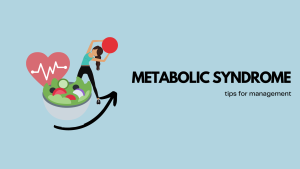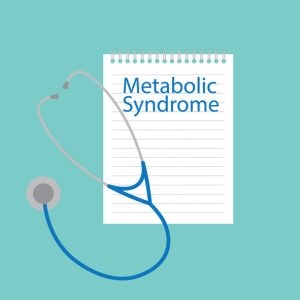


It is Diabetes Awareness Month

Metabolic Syndrome
More than one-third of adults in the U.S. and one in five Canadians, have been identified as having metabolic syndrome. While metabolic syndrome is commonly associated with heart disease, what you may not know is that it is also linked to diabetes. The good news is, making simple adjustments to your daily habits can reduce your overall risks.
What is metabolic syndrome?
Metabolic syndrome is a condition characterized by a cluster of symptoms associated with increased risks for developing certain chronic health conditions. When chemical reactions and processes within the body do not operate normally, it can lead to negative health outcomes.
What are the Risk Factors?
The following characteristics are known risks factors for metabolic syndrome:
• High blood sugars
• High triglycerides
• Low HDL cholesterol
• High blood pressure
• Carrying excess weight around the waistline
How to Reduce Your Risks
To reduce your risks, focus on these areas:
Maintain a healthy weight:
Developing healthy eating habits and weaving physical activity into your daily life is the key to maintain a healthy weight. If you are overweight, losing just 5% of your current body weight can reduce your risk of developing metabolic syndrome and diabetes by 58%.
Increase physical activity:
The best way to improve your HDL cholesterol is through physical activity. Aim for 150 to 300 minutes of moderate to vigorous exercise each week.
Stay current on preventive care:
Be sure to stay up to date on your preventive care, including lab draws and visits to your doctor. Many chronic health conditions can be prevented when identified early.
Lifestyle Habits That Can Reduce Your Health Risks
We hear a lot of the same recommendations when it comes to maintaining good health. So much so, that  you may even tune them out sometimes. As boring as many of them may be, these seemingly insignificant habits can really pay off in the long-run when it comes to your wellbeing.
you may even tune them out sometimes. As boring as many of them may be, these seemingly insignificant habits can really pay off in the long-run when it comes to your wellbeing.
Here are some healthy lifestyle habits to focus on to reduce your health risks:
Quit tobacco:
According to the American Cancer Society, a year after you quit smoking, your risk of heart disease is cut in half. Five years after that, the same goes for your risk of cancer.
Get sufficient restful sleep:
Aim to get at least seven hours of sleep each day. Insufficient sleep has been linked to abnormal levels of leptin and ghrelin, the key hormones that directly impact appetite and weight regulation.
Move your body:
Accumulate at least 150 to 300 minutes of moderate to vigorous physical activity each week. Staying physically active can reduce your risks for cardiovascular disease, depression, and diabetes.
Be grateful:
Expressing gratitude is linked to lower rates of depression and healthier relationships. Starting a gratitude journal is the easiest way to make gratitude part of your daily life.
Stay connected:
Invest in nurturing a supportive network that you can lean on when life feels overwhelming. People who have strong support systems have lower blood pressure and fewer symptoms of depression.
Today, I am grateful for?
When it comes to creating the conditions for good health, you hold more power than you realize. Focus on building healthy habits to protect your wellbeing & reduce your overall health risks.
The Microbiome: What it is and Why it is Important?
In 2001, the term microbiome began circulating within scientific communities. Defined as an “ecological community of commensal, symbiotic, and pathogenic microorganisms that literally share our body space,” the microbiome has been found to have direct ties to our health.
What is the Microbiome?
Our bodies contain roughly 100 trillion microorganisms. That is 10 times more than the number of cells in the human body. Weighing up to five pounds by some estimates, these microbes play a role in immune function, metabolism, and weight regulation.
Why Your Microbiome is Important?
The makeup of your microbiome is thought to determine, and sometimes even predict, your health risks. For example, it is now understood that people who are overweight have a different composition of microorganisms than people who are at a healthy weight. This has led some experts to believe that the bacteria in our gut are involved in metabolism and appetite regulation.
How to Support a Healthy Microbiome:
Poor eating habits can result in an imbalance (dysbiosis) of bacteria.  Specific foods have been shown to support the good bacteria in your gut, namely probiotics and prebiotics. To support your microbiome, choose more of these foods:
Specific foods have been shown to support the good bacteria in your gut, namely probiotics and prebiotics. To support your microbiome, choose more of these foods:
Pro-Biotics
Pro-Biotics are live bacteria. Fermented and cultured foods are easy to find in most supermarkets, but they can also be prepared at home. Good sources of probiotics include:
• Kombucha
• Yogurt
• Sauerkraut
• Kimchi
Pre-Biotics
Pre-Biotics are specific types of plant fibers that support the bacteria living in your digestive tract. Good sources of prebiotics include:
• Jerusalem Artichokes
• Dandelion Greens
• Chicory Root
• Onions
• Asparagus
Focus on high-fiber plants and fermented foods to support a strong microbiome.

Deep Fried Turkey Brined in Cayenne & Brown Sugar
Ingredients:
- 3 Cups of packed light brown sugar (about 1/4 pounds)
- 1 1/2 Cups of Dijon Mustard
- 1/4 Cup, plus 2 Tablespoons of Salt

- 2 Tablespoons of Cayenne Pepper
- 2 Gallons of cold water
- 1 Bunch of Thyme
- 1 Head of Garlic (separated into cloves & crushed)
- 12 Pound Turkey
- 2 1/2 Gallons of Vegetable Oil
Directions:
Step 1
In a large stockpot, whisk the brown sugar with the mustard, salt and cayenne pepper. Gradually whisk in the water, then add the thyme and garlic. Add the turkey, cover and brine in the refrigerator for 35 hours. YES, 35 HOURS IS CORRECT……
Step 2
In a turkey fryer or 18 quart (or larger) stockpot, bring the oil to 400 degrees; this can take up to an hour. Remove the turkey from the brine and pat it dry inside and out with paper towels. Transfer the turkey to a frying basket, breast side up.
Step 3
Lower the turkey into the hot oil and fry for 3 minutes per pound, 36 minutes for this 12 pound turkey. Lift the basket out of the fryer and drain the turkey on a rack set over a rimmed baking sheet for 15 minutes. Then, CARVE & SERVE!
Note: Cooking a fried turkey does require caution. You can use different kinds of cooking equipment, like a stockpot, electric fryer, pot & propane set up, or a deep fryer. The best deep fryers come with a thermostat and a metal basket for lowering the turkey into the hot oil and removing it once it is done.
Fry your turkey for 3 minutes for each pound!

